# EMSC 3002 ## Folds and Folding Mechanisms - Louis Moresi (convenor) - **Romain Beucher** (lecturer) - Chengxin Jiang (lecturer) - Stephen Cox (curriculum advisor) Australian National University **NB:** the course materials provided by the authors are open source under a creative commons licence. We acknowledge the contribution of the community in providing other materials and we endeavour to provide the correct attribution and citation. Please contact louis.moresi@anu.edu.au for updates and corrections. <--o--> <!-- .slide: data-background="Module-v-Ductile-Deformation/Figures-Folds-and-Folding-Mechanisms/photos/Fold_related_to_backsliding_of_Caledonian_nappes_Hardanger.jpg" --> <--o--> ## Resources 1. **Fossen, H, 2011.** *Structural Geology.* Cambridge University Press, 2nd Edition **Chapter 11** 1. **McClay, K.R. 1991.** *The Mapping of Geological Structures.* John Wiley & Sons. **Chapter 3** 1. **Park, R.G., 1995.** *Foundations of Structural Geology.* Blackie & Sons Ltd. **Chapter 2** 1. **Davis, G.H. and Reynolds, S.J., 1996.** *Structural Geology of Rocks and Regions.* 2nd Edition, John Wiley & Sons. **Chapter 7** <!-- 1. **Hatcher, R.D., 1990.** *Structural Geology - Principles, Concepts, and Problems*, 2nd Edition, Prentice-Hall --> <!-- 1. **Ramsay, J.G. and Huber, M.I. 1983.** *Modern Structural Geology. Volume 1: Strain Analysis.* Academic Press. --> <!-- 1. **Ramsay, J.G. and Huber, M.I. 1987.** *Modern Structural Geology. Volume 2: Folds and Fractures.* Academic Press. --> <--o--> ## Intended learning outcomes Students will be able to: - **Classify folds** according to fold terminology. - Understand **Folding Mechanims** - Find second order folds and cleavage <--o--> <!-- .slide: data-background="Module-v-Ductile-Deformation/Figures-Folds-and-Folding-Mechanisms/photos/Folds.jpg" --> <--o--> ## Introduction Folds are spectacular structures. They are great evidence of how the original shape of rocks can evolve during deformation. The shape and orientations of folds seems almost limitless, yet there are some patterns that stands out. In the following lecture we will observe and describe folds and we will attempt to understand folding mechanisms and history. <--o--> ## 3 fundamental mechanisms <div> <div style="width:50%; float:left"> Folds may form **actively** and originate from mechanical or rheological properties of the layering relative to the properties of the surrounding material. We talk about about **contrast in competence or viscosity** **Active folds** nucleate and grow as competent layers are shortened. This process is called **buckling** </div> <div style="width:50%; float:right"> 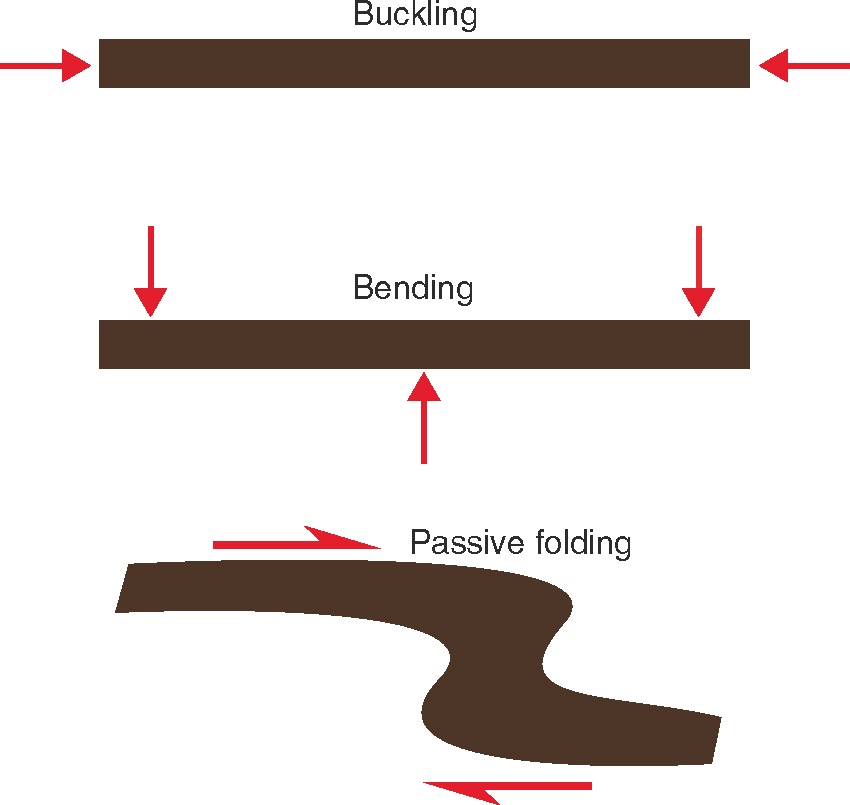 <!-- .element style="float: right" width="95%" --> </div> </div> <--o--> ## 3 fundamental mechanisms <div> <div style="width:50%; float:left"> Folding that occurs during flow in rocks without viscosity contrast is called **passive folding**. In that case, the layers are markers that are transported by the flow. **Passive folds** form in shear zones and are sometimes called **shear folds** Layers can also be bent as forces act across the layering, a mechanism called **bending** or **forced folding** </div> <div style="width:50%; float:right">  <!-- .element style="float: right" width="95%" --> </div> </div> <--o--> ## 3 fundamental mechanisms <div> <div style="width:50%; float:left"> Folding can occur in any tectonic regime (Extensional, Contractional, Strike-Slip) It can also occur at any level in the crust, from soft sediment folding to folding under the entire range of metamorphic conditions. </div> <div style="width:50%; float:right">  <!-- .element style="float: right" width="95%" --> </div> </div> <--o--> ## Different ways of forming folds <div> <div style="width:50%; float:left"> 1. **Buckle folds** - Layer parallel shortening. - Internal deformation within layer. - Flexural slip folds or Flexural flow mechanisms 1. **Bending folds** - At High level in crust above basement faults 1. **Passive folds** - Accentuates existing structures at high T. 1. **Shear folds** - Rare, found in shear zones. </div> <div style="width:50%; float:right">  <!-- .element style="float: right" width="95%" --> </div> </div> <--o--> ## Active Folding or Buckling <div> <div style="width:60%; float:left"> Buckling occurs when a competent layer in a less competent matrix is shortened parallel to the length of the layer. Buckling implies that there is: 1. Layer parallel shortening 1. Viscosity constrast 1. Irregularities on which folds can initiate </div> <div style="width:40%; float:right">  <!-- .element style="float: right" width="90%" --> </div> </div> <--o--> ## Active Folding or Buckling  <!-- .element style="float: center" width="90%" --> <--o--> <!-- .slide: data-background="Module-v-Ductile-Deformation/Figures-Folds-and-Folding-Mechanisms/photos/Fossen_Chapter11_Buckling.jpg" --> <--o--> ## Active Folding or Buckling ### Effect of layer obliquity  <!-- .element style="float: center" width="100%" --> <--o--> ## Active Folding or Buckling ### Effect of layer obliquity This layer probably buckled because the it has a higher comtence or viscosity than the surrounding matrix and could defom in a plastic manner.  <!-- .element style="float: center" width="85%" --> The layer-parallel shortening is difficult to affirm. The other vein gives us useful information. It is older (cross cut by the folded vein), but not folder which indicates that the shortening direction was at high angle to this unfolded vein. <--o--> ## Active Folding or Buckling ### Controlling Factors <div> <div style="width:40%; float:left"> Layers with different viscosities $\mu_1 < \mu_2$ Biot found from experiments... $\lambda = 2 \pi H_t \sqrt[3]{\frac{\mu_1}{6\mu_2}}$ Fold wavelength depends on layer thickness and viscosity contrast. </div> <div style="width:60%; float:right">  <!-- .element style="float: right" width="90%" --> </div> </div> <--o--> ## Active Folding or Buckling ### Buckling and Layer Thickness <div> <div style="width:50%; float:left"> A regular dominant wavelength is created as a function of layer Thickness, layer rheology and contrast in competence or viscosity. The following animation shows the role of thickness, keeping the competency contrast constant. </div> <div style="width:50%; float:right">  <!-- .element style="float: center" width="95%" --> </div> </div> <--o--> ## Active Folding or Buckling ### Buckling and Layer Thickness  <!-- .element style="float: right" width="50%" --> Different layer thicknesses and/or rheologies produce different wavelengths of folds. The geometry of the 2nd and 3rd order of folds show where the large structures are! <--o--> ## Active Folding or Buckling ### Buckling and Viscosity Contrast <div> <div style="width:50%; float:left"> Keeping the layer thickness constant shows the influence of competence contrast. **High contrast** create large wave lengths and amplitudes. **Low contrast** create small wave lengths and amplitudes. The least competent layer ends up much thicker than prior to deformation, more competent layer show less thickness changes. </div> <div style="width:50%; float:right"> 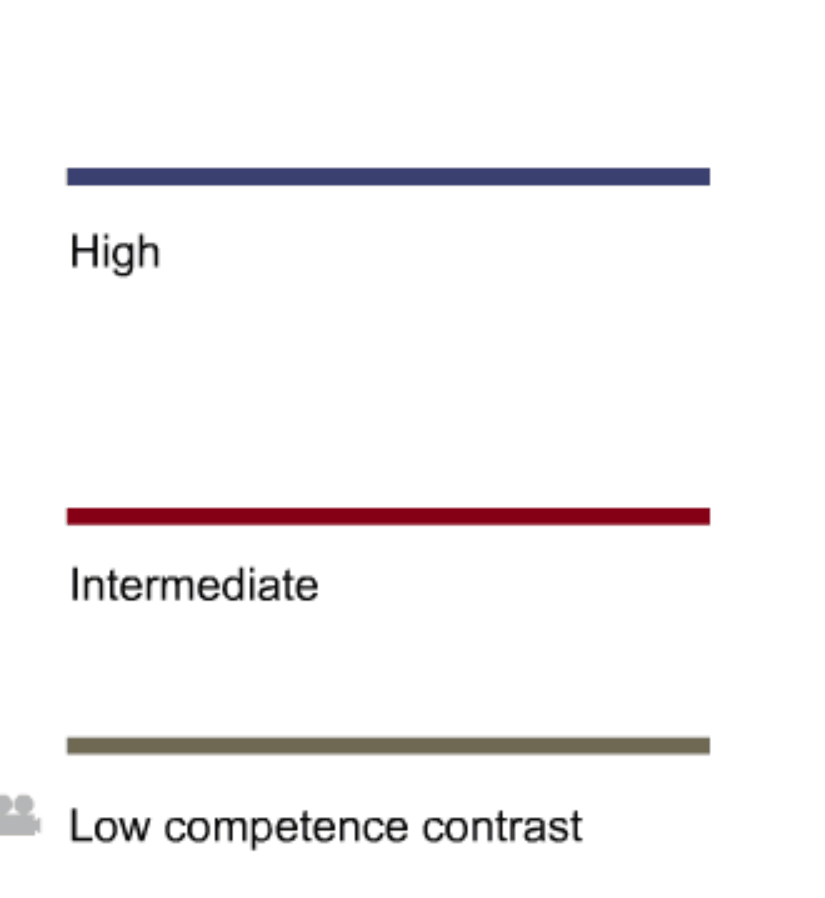 <!-- .element style="float: center" width="90%" --> </div> </div> <--o--> ## Active Folding or Buckling ### Buckling and Viscosity Contrast <div> <div style="width:50%; float:left"> Keeping the layer thickness constant shows the influence of competence contrast. **High contrast** create large wave lengths and amplitudes. **Low contrast** create small wave lengths and amplitudes. The least competent layer ends up much thicker than prior to deformation, more competent layer show less thickness changes. </div> <div style="width:50%; float:right"> 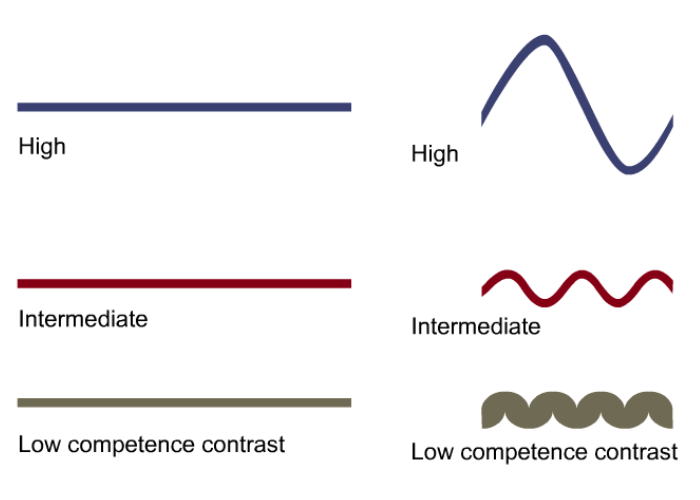 <!-- .element style="float: center" width="95%" --> </div> </div> <--o--> ## Active Folding or Buckling <div> <div style="width:55%; float:left"> ### Multilayers When layer are spread apart they behave as **single layers**. When they get close, they start to behave more like **a single layer** whose thickness is the sum of the individual layer thicknesses. </div> <div style="width:45%; float:right">  <!-- .element style="float: center" width="60%" --> </div> </div> <--o--> ## Active Folding or Buckling <div> <div style="width:60%; float:left"> ### Multilayers During buckling of alternately thin and thick competent layers, **the thin layers fold first**. Thick layers tend to go through a phase of layer thickening prior to folding. Thin layers produce small folds that are later folded by the thick layer. This result in two orders folds. The largest fold is first order, smaller folds are second order folds. Small folds become asymmetric along the limbs because of shear. Their assymetry reflects their position within the first order structure. </div> <div style="width:40%; float:right"> 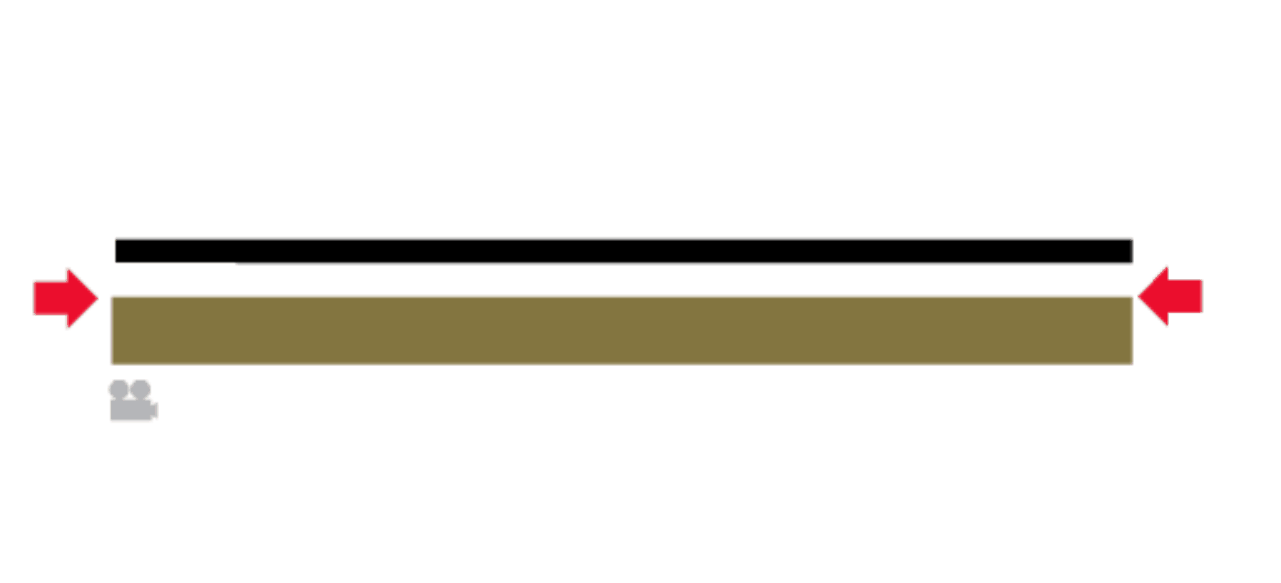 <!-- .element style="float: center" width="95%" --> </div> </div> <--o--> <!-- .slide: data-background="Module-v-Ductile-Deformation/Figures-Folds-and-Folding-Mechanisms/photos/Multilayers.jpg" --> <--o--> ## Active Folding or Buckling ### Flexural Slip <div> <div style="width:50%; float:left"> **Flexural Flow** and **Flexural slip** easily ocur during multilayer buckling. **Flexural slip** is similar to bending a pile of paper sheets. Flexural slip may leave evidence for bedding parallel slip such as slickenlines, shear fractures or shear deformation bands on the surface of bedding planes. Flexural slip maintain layer thickness. Slip increase down the limb from zero at the hinge points. Lines originally parallel do not remain so. </div> <div style="width:50%; float:right"> 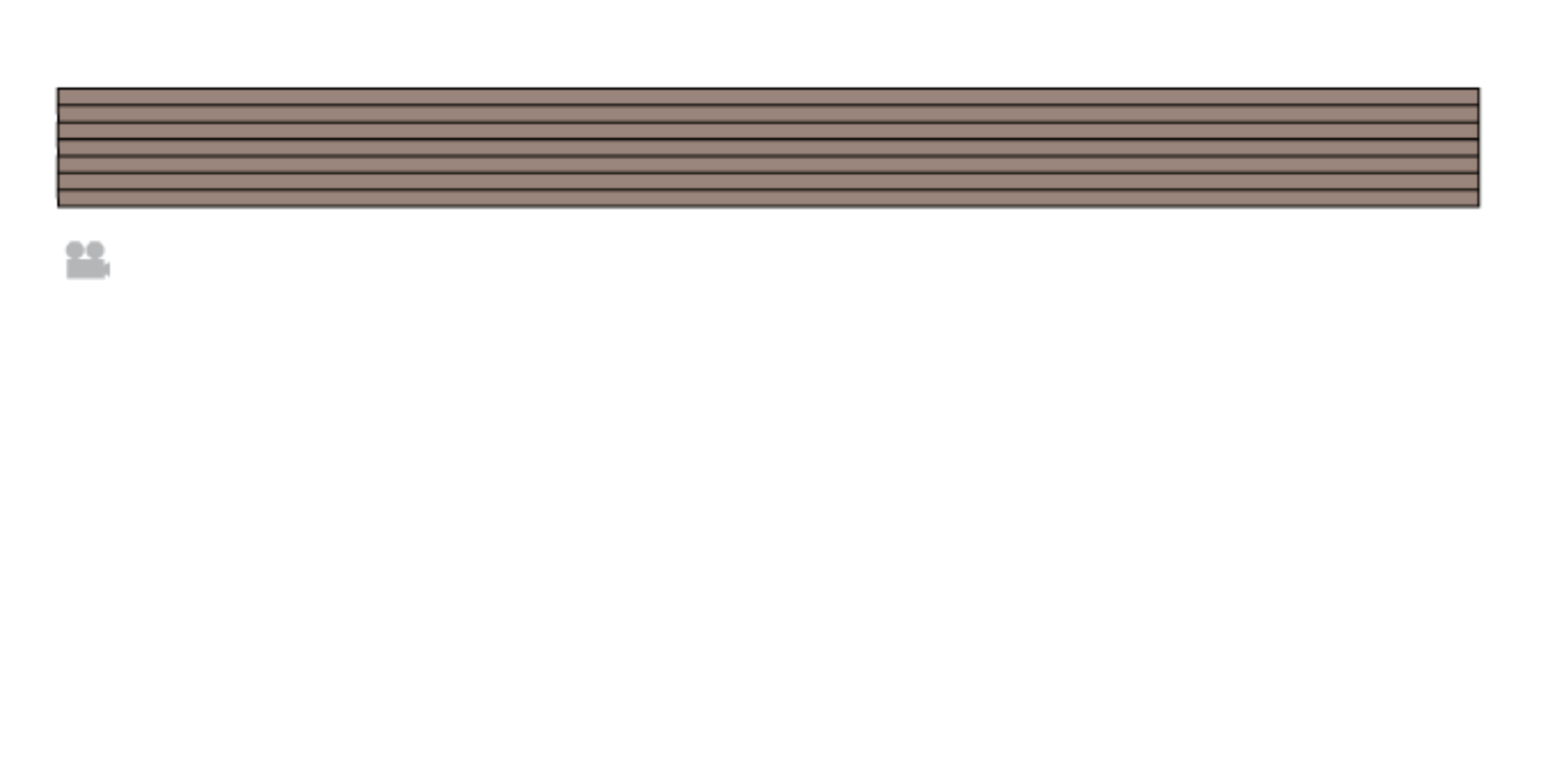 <!-- .element style="float: center" width="95%" --> </div> </div> <--o--> <!-- .slide: data-background="Module-v-Ductile-Deformation/Figures-Folds-and-Folding-Mechanisms/photos/Flexural_Slip_parallel_folds.jpg" --> <--o--> ## Active Folding or Buckling ### Flexural Slip <div> <div style="width:50%; float:left"> - Requires weak coupling between layers - Slip occurs on bedding planes - Bed thickness is constant - No slip at hinges Slickenlines on folded weak layers and constant bed thickness reveal flexural slip 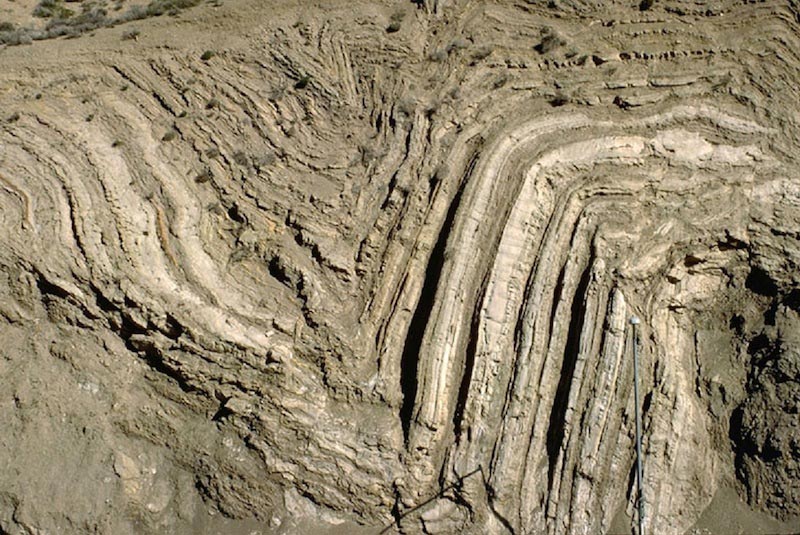 <!-- .element style="float: center" width="80%" --> </div> <div style="width:50%; float:right">  <!-- .element style="float: center" width="90%" --> </div> </div> <--o--> ## Active Folding or Buckling <div> <div style="width:50%; float:left"> ### Flexural Flow **Flexural Flow** is similar to **Flexural slip** except that the discrete slip layering-parallel surfaces are replaced by distributed shear. Strain is not discrete but ductile (at the scale of observation) Properties are (as for Flexural slip) - Constant layer thickness - Zero strain at hinge point, increasing down the limbs - Orthogonal and parallel lines do not remain so </div> <div style="width:50%; float:right"> 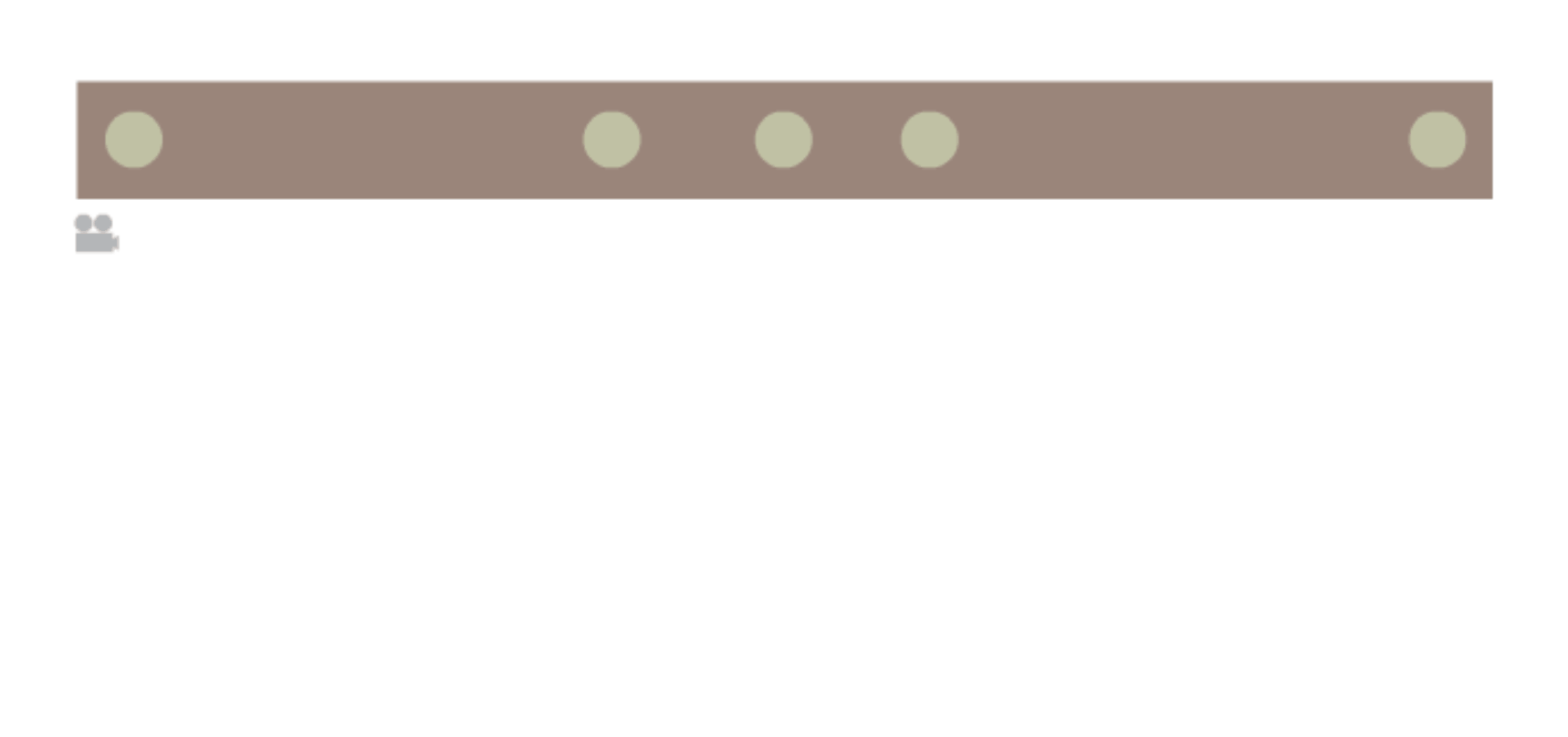 <!-- .element style="float: center" width="95%" --> </div> </div> <--o--> <!-- .slide: data-background="Module-v-Ductile-Deformation/Figures-Folds-and-Folding-Mechanisms/photos/Flexural_Flow_similar_folds.jpg" --> <--o--> ## Active Folding or Buckling <div> <div style="width:50%; float:left"> ### Flexural Flow - Requires some weak layers - within layer flow beds are sheared in limbs - Thickening in hinge - No shear at hinge 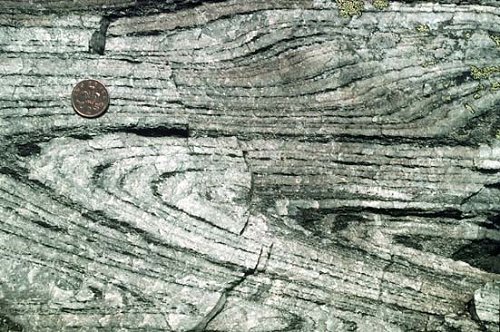 <!-- .element style="float: center" width="95%" --> </div> <div style="width:50%; float:right">  <!-- .element style="float: center" width="95%" --> </div> </div> <--o--> ## Active Folding or Buckling <div> <div style="width:50%; float:left"> ### Orthogonal Flexure - Lines initially orthogonal to the folded layers remain orthogonal. - A neutral surface separates outer arc extension from inner arc contraction - Result in parallel folds (Class 1B) </div> <div style="width:50%; float:right"> 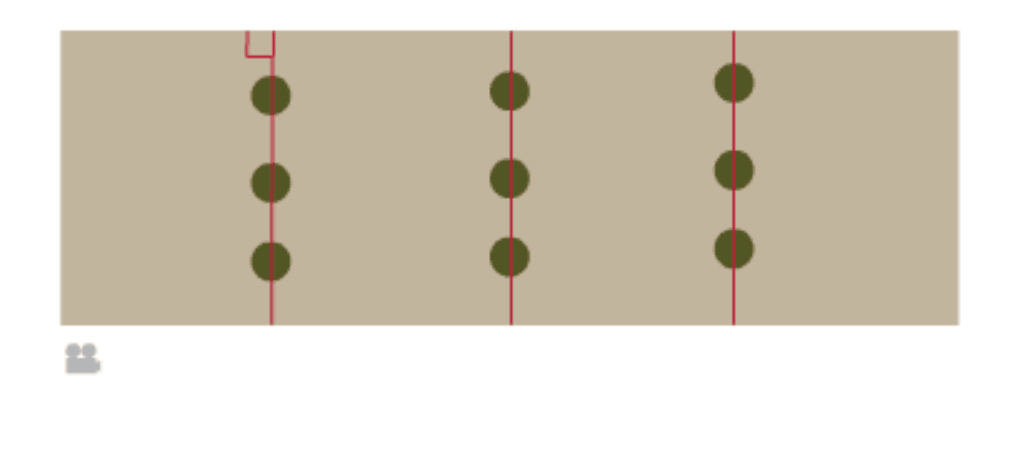 <!-- .element style="float: center" width="95%" --> </div> </div> <--o--> ## Active Folding or Buckling <div> <div style="width:50%; float:left"> ### Orthogonal Flexure - Lines initially orthogonal to the folded layers remain orthogonal. - A neutral surface separates outer arc extension from inner arc contraction - Result in parallel folds (Class 1B) </div> <div style="width:50%; float:right"> 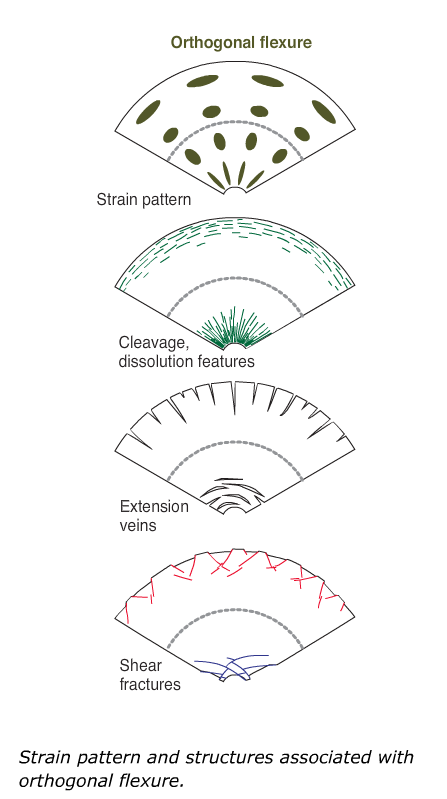 <!-- .element style="float: center" width="70%" --> </div> </div> <--o--> ## Active Folding or Buckling <div> <div style="width:50%; float:left"> ### Orthogonal Flexure *Example of outer arc stretching (vertical veins) and inner arc shortening (horizontal veins) in competent layers. Incompetent layers take on a different shape to accommodate the deformation between the outer arc of the lower competent layer and the inner arc of the one above (Chevron Folds, North Norway, Credit: Haakon Fossen.)* </div> <div style="width:50%; float:right">  <!-- .element style="float: center" width="80%" --> </div> </div> <--o--> ## Active Folding or Buckling <div> <div style="width:50%; float:left"> ### Inner arc collapse and additional strain Keep in mind that additional strain can be added before, during or after folding. In particular, there is commonly a phase of shortening prior to foding that may need to be accounted for when constructing a model. </div> <div style="width:50%; float:right">  <!-- .element style="float: center" width="95%" --> </div> </div> <--o--> ## Active Folding or Buckling <div> <div style="width:50%; float:left"> ### Inner arc collapse and additional strain Orthogonal flexure can be modified by allowing for volume reduction in the inner arc. In the following model, the outer arc maintain its length while the inner arc is highly shortened. The neutral surface can disappear for pure inner arc collapse. You would usually see evidence of inner arc bucling, dissolution features in the inner arc and no evidence of extension in the outer arc. </div> <div style="width:50%; float:right">  <!-- .element style="float: center" width="95%" --> </div> </div> <--o--> ## Active Folding or Buckling <div> <div style="width:50%; float:left"> ### Multilayer Hinges Stacking several folded competent layers create a space problem. This requires flexural flow within the incompetent layers. We also see squeezing of fold hinges and faults that result from hinge space problems. </div> <div style="width:50%; float:right"> 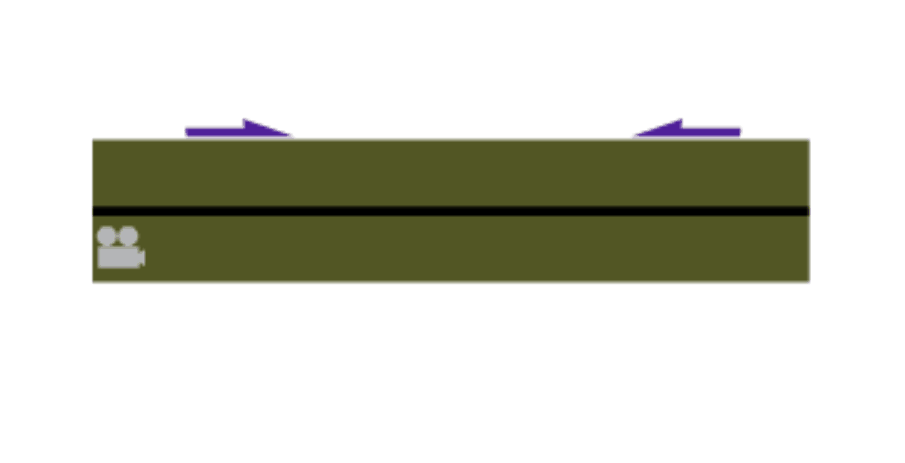 <!-- .element style="float: center" width="95%" --> 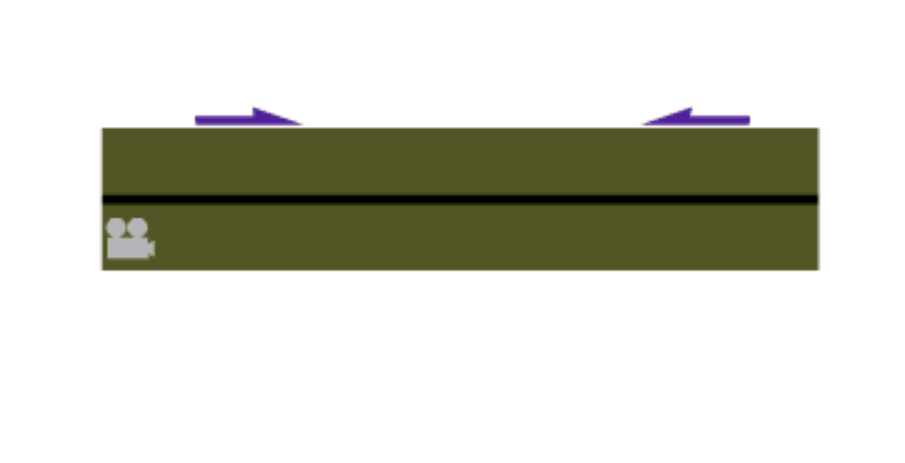 <!-- .element style="float: center" width="95%" --> </div> </div> <--o--> ## Active Folding or Buckling  <!-- .element width="95%" --> <--o--> ## Active Fodling or Buckling <div> <div style="width:50%; float:left"> ### Shearing Bucking also occurs during non-coaxial deformation, such as in shear zones. When the contrast in viscosity is sufficient, layers will fold in response to layer parallel shortening. During shearing, the rotating limb experiences early limb thickening and later attenuation. The reason is that it rotates into and then out of the instantaneous shortening field. This requires high competency contrast. </div> <div style="width:50%; float:right">  <!-- .element style="float: center" width="95%" --> </div> </div> <--o--> ## Passive Folding <div> <div style="width:50%; float:left"> **Passive Folding** involves passive flow of rocks. Layers are passive markers. Passive folds are similar (class 2) folds, which maintain constant thickness parallel to their axial surface. The simplest model is a **card deck**. When temperature gets high the competence contrast between rock layers can be reduced. Passive folding may then become dominant over buckling. </div> <div style="width:50%; float:right">  <!-- .element style="float: center" width="95%" --> </div> </div> <--o--> <!-- .slide: data-background="Module-v-Ductile-Deformation/Figures-Folds-and-Folding-Mechanisms/photos/SimilarFoldsCaledonides.jpg" --> <--v--> *Close to similar folds in the W Norway Caledonides. Credit Haakon Fossen* <--o--> ## Passive Folding <div> <div style="width:50%; float:left"> The card deck model implies opposite sense of shear on each side of the axial trace of the fold. If we starts out with a non-planar layering we can make passive folds in homogeneous simple shear. </div> <div style="width:50%; float:right">  <!-- .element style="float: center" width="95%" --> </div> </div> <--o--> ## Passive Folding <div> <div style="width:50%; float:left"> If we starts out the same non-planar layer we can equally make passive folds in homogeneous pure shear. However, the resulting passive fold will always be a similar fold with contsant thickness along the axial plane (see red lines). </div> <div style="width:50%; float:right">  <!-- .element style="float: center" width="95%" --> </div> </div> <--o--> ## Bending or forced folding <div> <div style="width:70%; float:left"> Bending or *forced folding* is passive in the sense that folding is not a consequence of competency contrasts. However, it commonly involves layer of contrasting competences Examples of bending in various settings - (a) between boudins - (b) above thrust ramps - (c) above reactivated faults - (d) above shallow intrusions or salt diapirs </div> <div style="width:30%; float:right">  <!-- .element style="float: center" width="90%" --> </div> </div> <--o--> ## Bending or forced folding ### Monoclines <div> <div style="width:50%; float:left"> Example are found where faults become buried under sediments and sedimentary rocks and are then reactivated. The resulting structure is a **monocline**. It can occur in normal and reverse sense of motion. If there is a contrast in competence, Flexural Slip and Flexural Flow can occur </div> <div style="width:50%; float:right">  <!-- .element style="float: center" width="95%" --> </div> </div> <--o--> ## Bending or forced folding ### Monoclines <div> <div style="width:50%; float:left"> Example are found where faults become buried under sediments and sedimentary rocks and are then reactivated. The resulting structure is a **monocline**. It can occur in normal and reverse sense of motion. If there is a contrast in competence, Flexural Slip and Flexural Flow can occur </div> <div style="width:50%; float:right"> 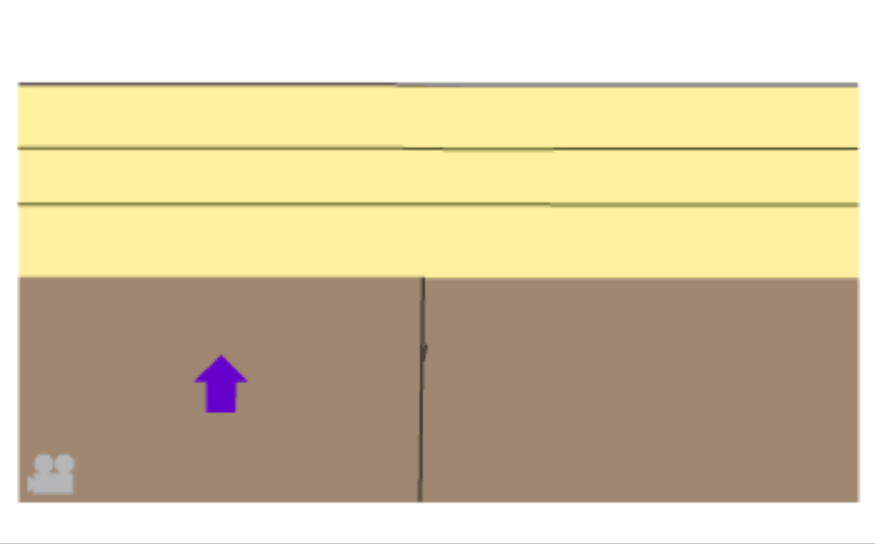 <!-- .element style="float: center" width="90%" --> </div> </div> <--o--> ## Bending <div> <div style="width:50%; float:left"> ### Ramps and fault propagation folds Bending does not result in folds with regular wave lengths because they are side effects of larger structures. *Example of forced folds in the hanging wall at fault ramp locations* </div> <div style="width:50%; float:right">  <!-- .element style="float: center" width="90%" -->  <!-- .element style="float: center" width="90%" --> </div> </div> <--o--> <!-- .slide: data-background="Module-v-Ductile-Deformation/Figures-Folds-and-Folding-Mechanisms/photos/faultbendfoldphotoredo.jpg" --> <--o--> <!-- .slide: data-background="Module-v-Ductile-Deformation/Figures-Folds-and-Folding-Mechanisms/photos/drag_fold.jpeg" --> <--o--> ## Bending <div> <div style="width:50%; float:left"> ### Diapir Large-scale bending can occur when salt or magma diapir rise toward the surface. </div> <div style="width:50%; float:right"> 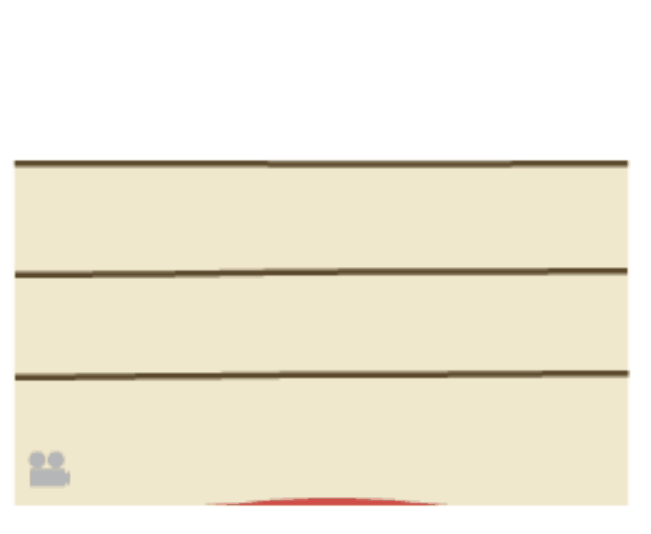 <!-- .element style="float: center" width="90%" --> </div> </div> <--o--> ## Bending <div> <div style="width:50%; float:left"> ### Boudinage Boudinage also generates forces that act across the layering. This happens where the boudins separate, commonly resulting in folding of the layers. </div> <div style="width:50%; float:right">  <!-- .element style="float: center" width="90%" --> </div> </div> <--o--> <!-- .slide: data-background="Module-v-Ductile-Deformation/Figures-Folds-and-Folding-Mechanisms/photos/Fossen_Passive_Folds_between_boudins.jpg" --> <--o--> ## Kinking and Chevron Folding <div> <div style="width:50%; float:left"> Strongly foliated rocks like schists commonly display kink folds that deform a pre-existing foliation. There are a several models to explain how kink band initiate. The simple shear example on the right is just one example. </div> <div style="width:50%; float:right"> 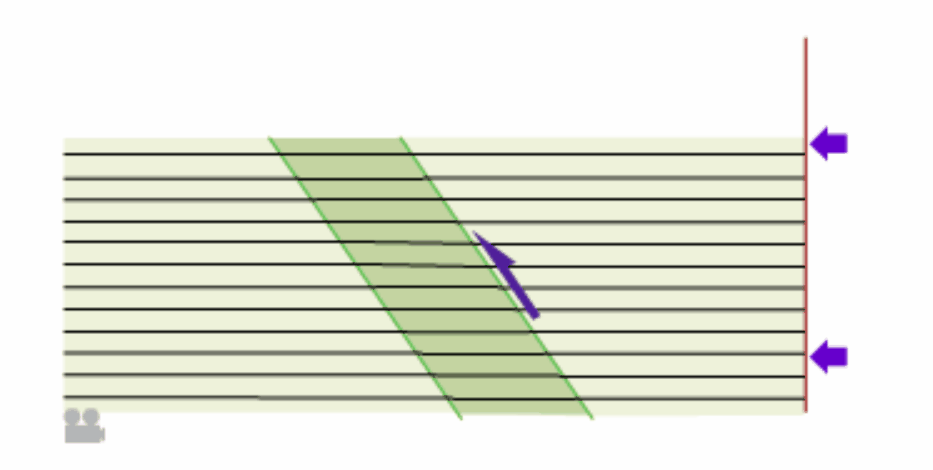 <!-- .element style="float: center" width="90%" --> </div> </div> <--o--> ## Kinking and Chevron Folding  <!-- .element width="50%" --> <--o--> <!-- .slide: data-background="Module-v-Ductile-Deformation/Figures-Folds-and-Folding-Mechanisms/photos/kink_fold_Bergen.jpg" --> <--o--> <!-- .slide: data-background="Module-v-Ductile-Deformation/Figures-Folds-and-Folding-Mechanisms/photos/Kink_folds_Oman_cherts.jpg" --> <--o--> # Conclusion The 3 mains mechanisms or folding are: - Buckling - Passive Folding - Bending It is common to find combination of the 3. For example, passive folding in shear zones may show local buckling. Mechanism listed under buckling such as Flexural flow and Flexural slip can also occur during bending. Bending means the layers are forced to fold. The way they deform depends on their mechanical properties. Always more complicated in nature! Folds may have complex histories with changing stress fields etc. Always require to compile and synthesize other relevant pieces of information to reconstruct the strain / stress history. <--o--> ## Superposed folds - fold interference patterns <div> <div style="width:50%; float:left"> Successive deformation phases (**$P_1$**, **$P_2$** etc.) can results in superimposition of fold generations (**$F_1$**, **$F_2$** etc.). Folds modified by a later phase are known as **refolded folds** and the resulting pattern is known as **fold interference patterns**. </div> <div style="width:50%; float:right"> 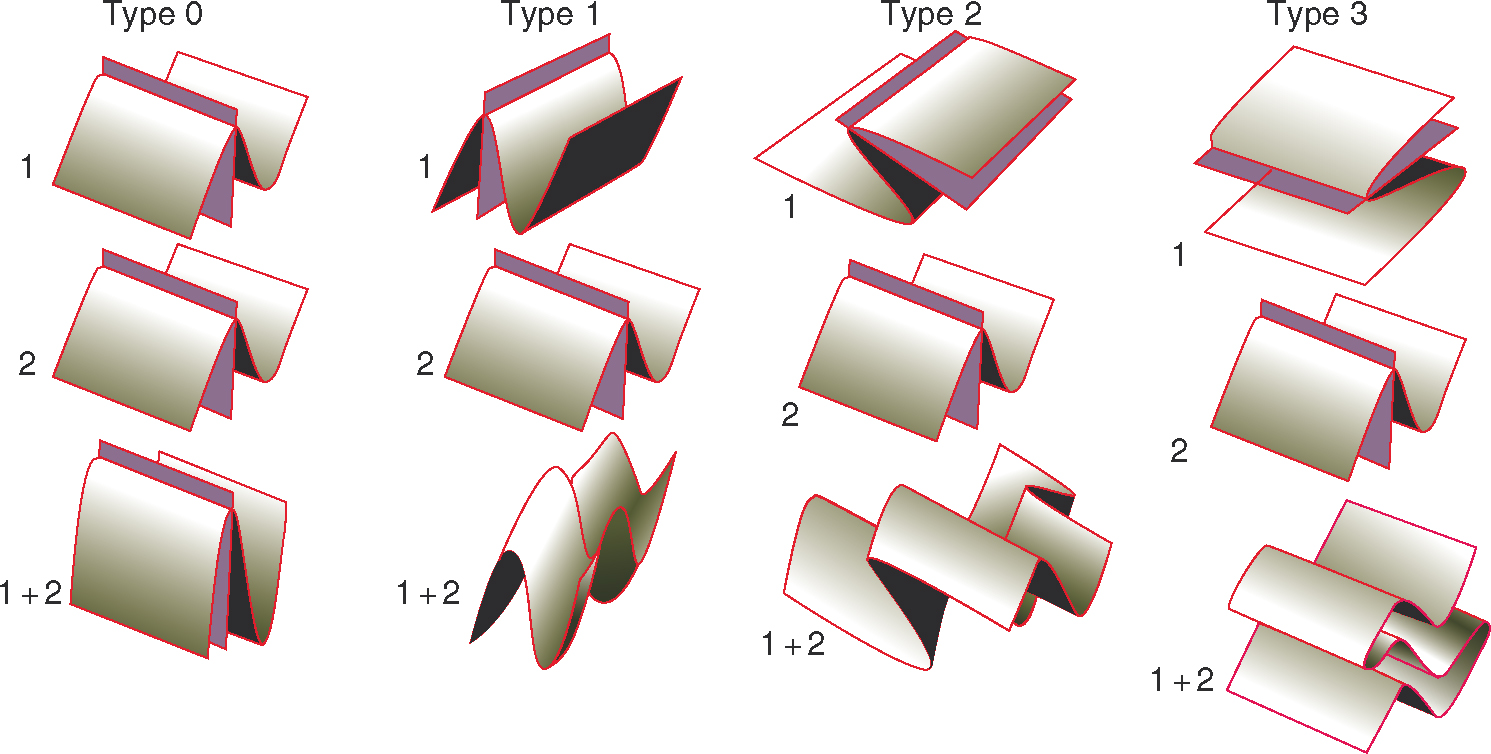 <!-- .element style="float: center" width="95%" --> </div> </div> <--o--> ## Superposed folds - fold interference patterns <div> <div style="width:60%; float:left"> There are 4 main patterns (0, 1, 2, 3) based on the angle between the fold axes and the axial planes. </div> <div style="width:40%; float:right"> 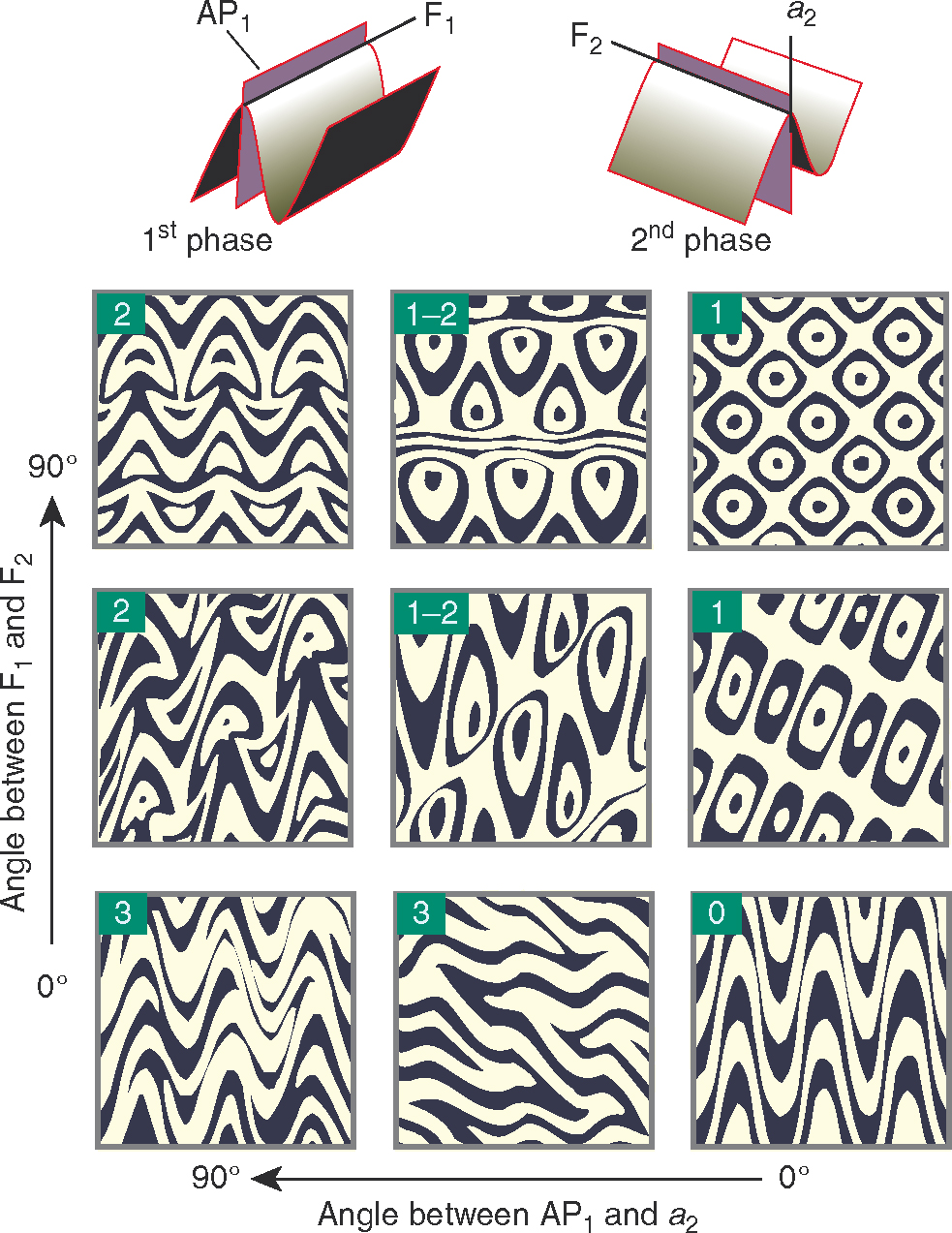 <!-- .element style="float: center" width="90%" --> </div> </div> <--o--> <!-- .slide: data-background="Module-v-Ductile-Deformation/Figures-Folds-and-Folding-Mechanisms/photos/FossenInterferenceFolds.jpg" --> <--o--> ## Sheath folds  <!-- .element style="float: right" width="95%" --> <--o--> ## Vergence concepts The facing of a fold system refers to the geographic direction of younging (shown with an arrow) of the long limbs of its parasitic folds. In a fold system, such as the one presented below, the facing is changing as one crosses major fold hinges. Indeed from west to east, this fold system is facing west upward, then east downward, then west upward, and east. The concept of vergence refers to the general sense of shear involved in the development of asymmetric folds. The fold systems shown below is verging east as the asymmetry is the result of a shearing toward the east. Unfortunately the world vergence is also used to refer to the direction of the next anticlinal closure. Changes in fold asymmetry, cleavage-bedding relationships, facing, and shear vergence occurs across fold hinges. Determination of two of these criteria constrain the two others. <--o--> ## Folding in Extensional Environment <div> <div style="width:30%; float:left"> Listric faults lead to hanging-wall deformation - adaptation folds and drag folds. Many faults form ramp-flat systems. Incompetent layers (clays, salts) form the flats, whereas ramps go through competent units. Detachment faults are large scale flats. </div> <div style="width:70%; float:right">  <!-- .element style="float: right" width="95%" --> </div> </div>